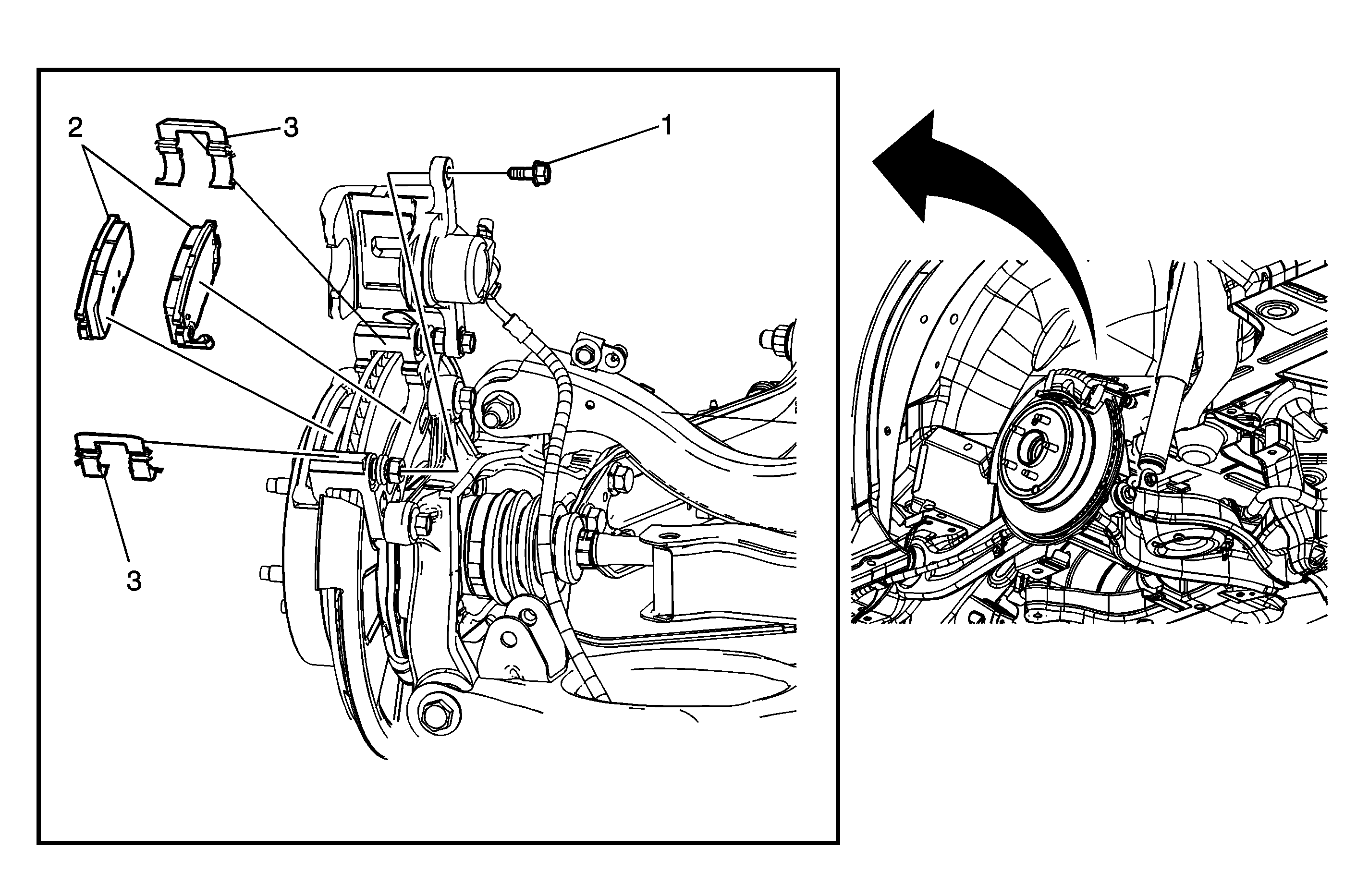Callout
| Component Name
|
|
Caution: Refer to Brake Dust Caution in the Preface section.
Notice: Support the brake caliper with heavy mechanic wire, or equivalent,
whenever it is separated from its mount and the hydraulic flexible brake hose is still connected. Failure to support the caliper in this manner will cause the flexible brake hose to bear the weight of the caliper, which may cause damage to the brake hose and
in turn may cause a brake fluid leak.
Preliminary Procedures
- Inspect the fluid level in the brake master cylinder reservoir.
- If the brake fluid level is midway between the maximum-full point and the minimum allowable level, no brake fluid needs to be removed from the reservoir before proceeding.
- If the brake fluid level is higher than midway between the maximum-full point and the minimum allowable level, remove brake fluid to the midway point before proceeding.
- Raise and support the vehicle. Refer to
Lifting and Jacking the Vehicle.
- Remove the tire and wheel. Refer to
Tire and Wheel Removal and Installation.
|
1
| Guide Pin Bolt
Notice: Refer to Fastener Notice in the Preface section.
Procedure
- Install an open end wrench to hold the caliper guide pin in line with the brake caliper while removing or installing the caliper guide pin bolt. DO NOT allow the open end wrench to come in contact with the brake caliper. Allowing the open end wrench
to come in contact with the brake caliper will cause a pulsation when the brakes are applied.
- Rotate the caliper up and to the rear until it rests on the mounting bracket and support with heavy mechanics wire or equivalent.
- Place a block of wood or an old brake pad against the brake caliper piston.
- Using a brake pad spreader tool or equivalent, fully seat the caliper piston in the caliper bore.
- If reusing the guide pin bolt, the threads of the guide pin bolt and the threads of the guide pin must be free of threadlocker residue and debris prior to the application of threadlocker to ensure proper adhesion and fastener retention.
If reusing the guide pin bolt, prepare the guide pin bolt and the guide pin as follows:
| 5.1. | Thoroughly clean the threadlocker residue from the guide pin bolt threads with denatured alcohol or equivalent and allow to dry. |
| 5.2. | Thoroughly clean the threadlocker residue from the guide pin threads with denatured alcohol or equivalent and allow to dry. |
| 5.3. | Apply high temperature, high strength threadlocker to 2/3 of the threaded length of the guide pin bolt. Ensure there are no gaps along the length of the filled area of the guide pin bolt. |
| 5.4. | Allow the threadlocker to cure approximately 10 minutes before installing the guide pin bolt. |
Tighten
27 N·m (20 lb ft) |
2
| Brake Pad (Qty: 2)
Procedure
- If installing the original brake pads, mark the position of the brake pads and springs.
- Position the brake pad with the wear indicator facing the inboard surface of the brake rotor.
|
3
| Spring (Qty: 2)
Procedure
- If replacing the brake pads, DO NOT reuse the springs. Install NEW springs.
- With the engine OFF, gradually apply the brake pedal to approximately 2/3 of its travel distance.
- Slowly release the brake pedal.
- Wait 15 seconds, then repeat steps 2-3 until a firm brake pedal is obtained. This will properly seat the brake caliper pistons and brake pads.
- Fill the master cylinder reservoir to the proper level. Refer to
Master Cylinder Reservoir Filling.
- Burnish the pads and rotors. Refer to
Brake Pad and Rotor Burnishing.
|

